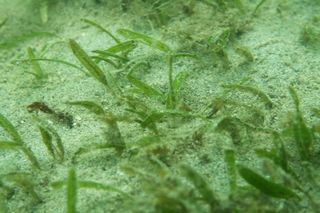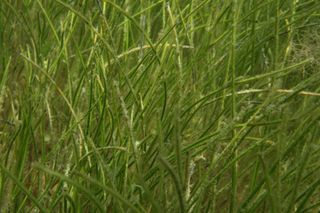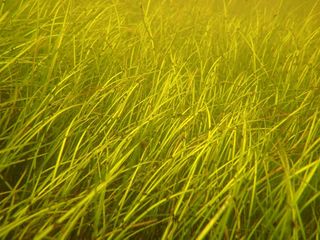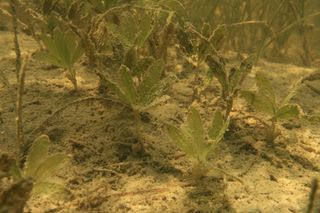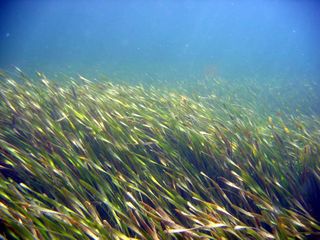Seagrass: Difference between revisions
mNo edit summary |
mNo edit summary |
||
| (5 intermediate revisions by the same user not shown) | |||
| Line 3: | Line 3: | ||
<p class="irlsubtitle">There are seven species of seagrass in the Indian River Lagoon.</p> | <p class="irlsubtitle">There are seven species of seagrass in the Indian River Lagoon.</p> | ||
<div class="irlcontenttop"> | <div class="irlcontenttop"> | ||
[[File:Johnsons-seagrass-002.jpg| | [[File:Johnsons-seagrass-002.jpg|320px|thumb|right|alt=Johnson's Sea Grass in the Indian River Lagoon|'''Johnson's Sea Grass''']] | ||
Seagrasses are grass-like flowering plants that live completely submerged in marine and estuarine waters. Although seagrasses occur throughout the coastal areas of Florida, they are most abundant in Florida Bay and from Tarpon Springs northward to Apalachee Bay in the Gulf, which are two of the most extensive seagrass beds in continental North America. Seagrasses occur in protected bays and lagoons and also in deeper waters along the continental shelf in the Gulf of Mexico. The depth at which seagrasses occur is limited by water clarity because most species require high levels of light. | |||
Florida's approximately 2.2 million acres of seagrasses perform many significant functions. | |||
* Maintain water clarity by trapping fine sediments and particles with their leaves. | |||
* Stabilize the bottom with their roots and rhizomes. | |||
* Provide shelter for fishes, crustaceans and shellfish. | |||
* Along with the organisms that grow on them, provide food for many marine animals and water birds. | |||
The canopy of seagrass protects smaller marine animals, including the young of such species as drums, sea bass, snappers and grunts, from larger predators. Some animals, such as manatees, urchins, conches and sea turtles, eat seagrass blades. Other animals derive nutrition from eating algae and small animals that live upon seagrass leaves. Bottlenose dolphins and a variety of wading and diving birds also use seagrass beds as feeding grounds. Seagrass-based detritus formed by the microbial breakdown of leaves and roots is also an important food source. | |||
</div> | </div> | ||
<div class="irlcontentmiddle"> | <div class="irlcontentmiddle"> | ||
==Indian River Lagoon Seagrass Species== | ==Indian River Lagoon Seagrass Species== | ||
<div style="width:100%;float:left"> | <div style="width:100%;float:left"> | ||
[[File:Johnson's_seagrass.jpg|120px|thumb|right|Johnson's Sea Grass]] | [[File:Johnson's_seagrass.jpg|120px|thumb|right|alt=Johnson's Sea Grass|Johnson's Sea Grass]] | ||
===Johnson's Seagrass=== | ===Johnson's Seagrass=== | ||
| Line 14: | Line 24: | ||
</div> | </div> | ||
<div style="width:100%;float:left"> | <div style="width:100%;float:left"> | ||
[[File:Manatee_seagrass.jpg|120px|thumb|right|Manatee grass]] | [[File:Manatee_seagrass.jpg|120px|thumb|right|alt=Manatee grass|Manatee grass]] | ||
===Manatee Grass=== | ===Manatee Grass=== | ||
| Line 20: | Line 30: | ||
</div> | </div> | ||
<div style="width:100%;float:left"> | <div style="width:100%;float:left"> | ||
[[File:Paddle_seagrass.jpg|120px|thumb|right| | [[File:Paddle_seagrass.jpg|120px|thumb|right|alt=Paddle grass|Paddle grass]] | ||
===Paddle Grass=== | ===Paddle Grass=== | ||
| Line 26: | Line 36: | ||
</div> | </div> | ||
<div style="width:100%;float:left"> | <div style="width:100%;float:left"> | ||
[[File:Shoal_seagrass.jpg|120px|thumb|right|Shoal grass]] | [[File:Shoal_seagrass.jpg|120px|thumb|right|alt=Shoal grass|Shoal grass]] | ||
===Shoal Grass=== | ===Shoal Grass=== | ||
| Line 32: | Line 42: | ||
</div> | </div> | ||
<div style="width:100%;float:left"> | <div style="width:100%;float:left"> | ||
[[File:Star_seagrass.jpg|120px|thumb|right|Star grass]] | [[File:Star_seagrass.jpg|120px|thumb|right|alt=Star grass|Star grass]] | ||
===Star Grass=== | ===Star Grass=== | ||
| Line 38: | Line 48: | ||
</div> | </div> | ||
<div style="width:100%;float:left"> | <div style="width:100%;float:left"> | ||
[[File:Turtle_seagrass.jpg|120px|thumb|right|Turtle grass]] | [[File:Turtle_seagrass.jpg|120px|thumb|right|alt=Turtle grass|Turtle grass]] | ||
===Turtle Grass=== | ===Turtle Grass=== | ||
| Line 44: | Line 54: | ||
</div> | </div> | ||
<div style="width:100%;float:left"> | <div style="width:100%;float:left"> | ||
[[File:Widgeon_seagrass.jpg|120px|thumb|right|Widgeon grass]] | [[File:Widgeon_seagrass.jpg|120px|thumb|right|alt=Widgeon grass|Widgeon grass]] | ||
===Widgeon Grass=== | ===Widgeon Grass=== | ||
| Line 50: | Line 60: | ||
</div> | </div> | ||
</div> | </div> | ||
<div class="irlcontentbottom"> | <div class="irlcontentmiddle"> | ||
==Seagrass Images== | |||
[[File:Johnsons_grass.jpg|left|320px|thumb|alt=Johnson's seagrass image|Johnson's Seagrass ''(Halophila johnsonii)'']] | |||
[[File:Manatee_grass.jpg|left|320px|thumb|alt=Manatee seagrass image|Manatee Grass ''(Syringodium filiforme)'']] | |||
[[File:Shoal_grass.jpg|left|320px|thumb|alt=Shoal seagrass image|Shoal Grass ''(Halodule wrightii)'']] | |||
[[File:Star_grass.jpg|left|320px|thumb|alt=Star seagrass image|Star Grass ''(Halophila engelmannii)'']] | |||
[[File:Turtle_grass.jpg|left|320px|thumb|alt=Turtle seagrass image|Turtle Grass ''(Thalassia testudinum)'']] | |||
</div> | |||
<div class="irlcontentbottom noprint"> | |||
==See Also== | ==See Also== | ||
[[Johnson's Seagrass]] | [[Johnson's Seagrass]] | ||
==Web Links== | |||
* [https://www.sjrwmd.com/waterways/indian-river-lagoon/seagrass SJRWMD Seagrasses of the Lagoon] | |||
* [https://edis.ifas.ufl.edu/in189 Seagrass Beds of the Indian River Lagoon] | |||
==Documents== | ==Documents== | ||
| Line 58: | Line 80: | ||
* [https://www.govinfo.gov/content/pkg/FR-2000-04-05/pdf/00-8394.pdf NOAA:Johnsons Seagrass Critical Habitat] | * [https://www.govinfo.gov/content/pkg/FR-2000-04-05/pdf/00-8394.pdf NOAA:Johnsons Seagrass Critical Habitat] | ||
* [https://repository.library.noaa.gov/view/noaa/15973 NOAA 2002 Recovery plan for Johnson's seagrass (PDF 110pp 640KB)] | * [https://repository.library.noaa.gov/view/noaa/15973 NOAA 2002 Recovery plan for Johnson's seagrass (PDF 110pp 640KB)] | ||
</div> | </div> | ||
{{IRL footer estuary|cat=Biota}} | {{IRL footer estuary|cat=Biota}} | ||
</div> | </div> | ||
[[Category:Flora]] | [[Category:Flora]] | ||
Latest revision as of 15:48, December 29, 2021
There are seven species of seagrass in the Indian River Lagoon.
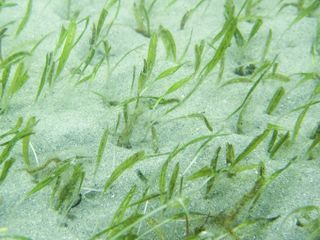
Seagrasses are grass-like flowering plants that live completely submerged in marine and estuarine waters. Although seagrasses occur throughout the coastal areas of Florida, they are most abundant in Florida Bay and from Tarpon Springs northward to Apalachee Bay in the Gulf, which are two of the most extensive seagrass beds in continental North America. Seagrasses occur in protected bays and lagoons and also in deeper waters along the continental shelf in the Gulf of Mexico. The depth at which seagrasses occur is limited by water clarity because most species require high levels of light.
Florida's approximately 2.2 million acres of seagrasses perform many significant functions.
- Maintain water clarity by trapping fine sediments and particles with their leaves.
- Stabilize the bottom with their roots and rhizomes.
- Provide shelter for fishes, crustaceans and shellfish.
- Along with the organisms that grow on them, provide food for many marine animals and water birds.
The canopy of seagrass protects smaller marine animals, including the young of such species as drums, sea bass, snappers and grunts, from larger predators. Some animals, such as manatees, urchins, conches and sea turtles, eat seagrass blades. Other animals derive nutrition from eating algae and small animals that live upon seagrass leaves. Bottlenose dolphins and a variety of wading and diving birds also use seagrass beds as feeding grounds. Seagrass-based detritus formed by the microbial breakdown of leaves and roots is also an important food source.
Indian River Lagoon Seagrass Species
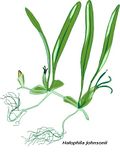
Johnson's Seagrass
Johnson's Seagrass (Halophila johnsoni) is found only in southeast Florida, including the southern half of the lagoon. Johnson’s seagrass is short, one to two inches long, with paired leaves that have central veins originating from a single node on a rhizome. It can form dense patches, with patches often split between deep water and shallow shoals, possibly due to competition for light with larger species. Johnson’s seagrass was named in honor of J. Seward Johnson Sr., founder of Harbor Branch Oceanographic Institution in Fort Pierce. The National Marine Fisheries Service considers Johnson’s seagrass to be a threatened species under the Endangered Species Act, due to its limited ability to reproduce and its limited distribution.
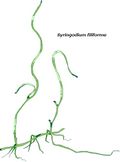
Manatee Grass
Manatee grass (Syringodium filiforme) is found at mid-depths (5 feet) throughout the lagoon and can grow to lengths of 14 inches. It is rarely found in shallow water, and is often found in mixed beds with other species. The blades of this seagrass are cylindrical, with two to four blades arising from each node in the rhizome. As denoted by its common name, manatees prefer to feed on Syringodium.
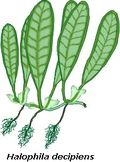
Paddle Grass
Paddle grass (Halophila decipiens) is the only species in the lagoon that is an annual, which means its blades are lost in cold weather and reemerge in warm weather. It generally is found in deeper water, and it is most abundant at the southern end of the lagoon, south of Sebastian Inlet. The blades, between one-half inch to an inch in length, resemble those of Johnson’s seagrass, but they have small notches on their margins, a broader paddle-shape and more rounded tips.
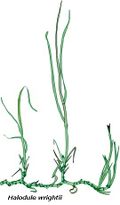
Shoal Grass
Shoal grass (Halodule wrightii) is the most common of the seagrasses, and it can be found throughout the lagoon. It is most abundant in shallow water (less than 6.5 feet), and it tolerates a range of salinities. Clusters of multiple leaves, with notches at their tips, originate from a single node along a creeping, branched rhizome (a stem that grows horizontally and gives rise to both leaves and roots) and can grow to lengths of four to 10 inches. Shoal grass is considered a pioneer species because it can grow and spread quickly to stabilize the sediment.

Star Grass
Star grass (Halophila engelmannii) generally is more common in the northern lagoon, but it can be found throughout the system. Star grass grows at a range of depths and sometimes with other species in mixed beds. Whorls of four to eight blades, one-half inch to an inch long, grow from a single stem forming a star-like pattern.
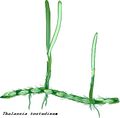
Turtle Grass
Turtle grass (Thalassia testudinum) can be found in the southern half of the lagoon (south of Sebastian Inlet) at mid-depths. Blades of turtle grass are flat and ribbon-like, growing to 14 inches long and a half inch wide. Blades can lengthen up to one inch per week under ideal conditions. Thalassia has the highest requirement for light of all the sea grasses in the lagoon, and it is an excellent indicator of healthy, stable water quality.
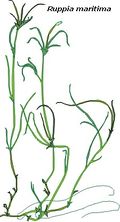
Widgeon Grass
Widgeon grass (Ruppia maritima) grows in patches throughout the lagoon in very shallow water (often less than 1 foot), and it can be found in areas with low salinity. The blades arise alternately from a sheath and they are wider at their bases and taper to long pointed tips. This grass closely resembles shoal grass, but its blades lack notches at their tips.

